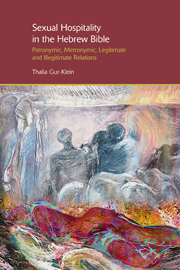 Sexual Hospitality in the Hebrew Bible
Sexual Hospitality in the Hebrew Bible Book contents
- Frontmatter
- Contents
- Acknowledgements
- Introduction
- 1 Patriarch hospitality and sexual hospitality
- 2 Marital and non-marital systems
- 3 Baal marriage of dominion
- 4 Metronymic marriage: remaining with kin – counter-patterns of baal marriage
- 5 Intersecting patterns and conflicting imperatives
- 6 Widow marriage, land and kin surrogacy
- Epilogue: moral imagination
- Notes
- Bibliography
- Index
Epilogue: moral imagination
- Frontmatter
- Contents
- Acknowledgements
- Introduction
- 1 Patriarch hospitality and sexual hospitality
- 2 Marital and non-marital systems
- 3 Baal marriage of dominion
- 4 Metronymic marriage: remaining with kin – counter-patterns of baal marriage
- 5 Intersecting patterns and conflicting imperatives
- 6 Widow marriage, land and kin surrogacy
- Epilogue: moral imagination
- Notes
- Bibliography
- Index
Summary
In Reflections on the French Revolution, Edmund Burke (1729–97) epitomized the term ‘moral imagination’ as a store of ‘super-added ideas that the heart owns, and the understanding ratifies, necessary to cover the defects of our naked shivering nature’ (Burke [1909] 2001: 14, 28). ‘Moral imagination’ has become a common term employed in ethics, literary criticism and politics (see www.scholar.google.com). In my understanding, Burke's ‘moral imagination’ conjures our insight into the role we play in the life of others, understanding the harm and pain but also the redemption and reciprocity we may generate by our ability to conceive it by the power of the imagination.
Rounding up five years of research on forms of marriage and family relations, the story of Ruth has led me to conclude that what determines people's actions and relationships are choices, reciprocity and ‘moral imagination’, while their lives are entrenched in socio-economic factors. While the story of Ruth extols the value of kinship, customs and laws, ‘moral imagination’ is conceived in the protagonists' ability to manoeuvre between self-interest, imperatives, mores and customs; at the end of the day, going against the grain modifies customs and laws, interlacing the human factor. This motif connects Naomi and Ruth, who take a dubious course, with the story of Tamar, in which the laws of adultery demand death but the human factor eventually precipitates reconciliation.
- Type
- Chapter
- Information
- Sexual Hospitality in the Hebrew BiblePatronymic, Metronymic, Legitimate and Illegitimate Relations, pp. 304 - 306Publisher: Acumen PublishingPrint publication year: 2013


